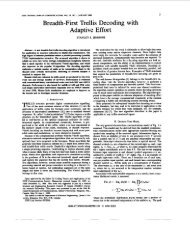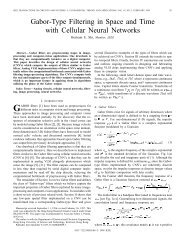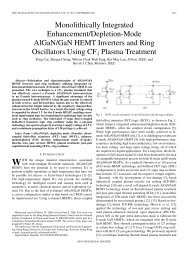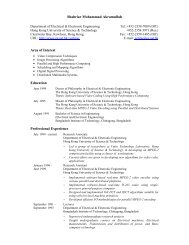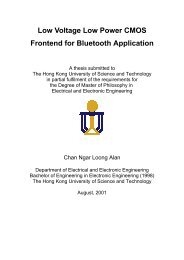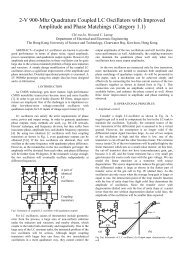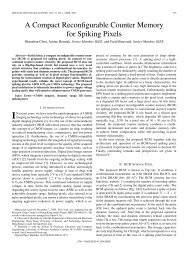Thesis - Department of Electronic & Computer Engineering
Thesis - Department of Electronic & Computer Engineering
Thesis - Department of Electronic & Computer Engineering
You also want an ePaper? Increase the reach of your titles
YUMPU automatically turns print PDFs into web optimized ePapers that Google loves.
τ---- d [ v , which shows that willdt i() t – v j() t ] = – [ v i() t – v j() t ] + ( I i– I j)v j() teither stay below zero or become case I.Case III:v i() t > 0,v j() t < 0τ---- d [ v , which shows thatdt i() t – v j() t ] = – [ v i() t – v j() t ] + ( I i– I j) + ( a + b)v i() tv j() twill either stay below zero or become case I.I i – I jLemma 4: ∀i,j ∈ { 1 , …,N }, if v i( 0) < v j( 0)and ------------- ≥ δ ,∃T i< ∞,∀t > T i , v i () t > v j () t .I iPro<strong>of</strong>:τ---- d [ vdt i() t – v j() t ] = – [ v i() t – v j() t ] + ( I i– I j) + ( a + b) [ f i() t – f j() t ]There are three cases to be considered.Case I:v j () t > v i () t > 0τ---- d [ vdt i () t – v j () t ] = ( a + b – 1) [ v i () t – v j () t ] + ( I i – I j )If a + b–1 ≤ 0, then τ---- d [ v ; As long asdt i () t – v j () t ] > I i – I j > 0v j () t ≥ v i () t ,d---- [ vdt i() t – v j() t ] > I i– I j> 0 will always hold, so there must exist T i< ∞ ,∀t> T i, v i() t > v j() t .72



